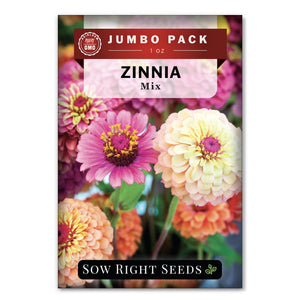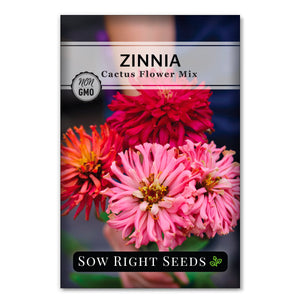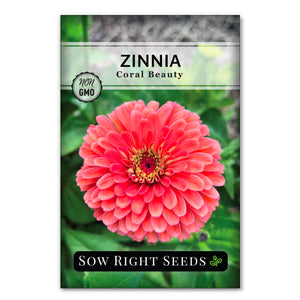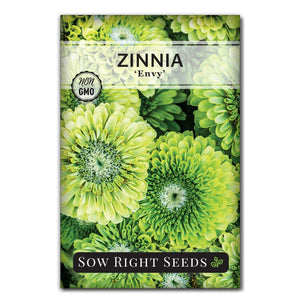How to Grow Zinnias - The secrets to keeping vibrant blooms all summer
ZinniasZinnias are one of the most rewarding flowers to grow. They germinate quickly and can be sown directly outside or started indoors. Zinnias seem determined to bloom no matter what, and the more you cut them, the more they grow. Learn the simple techniques to grow this beautiful flower and enjoy vibrant blooms all summer.

Table of Contents
How to Grow Zinnias From Seed
Zinnias are one of the easiest flowers to grow from seed. We love growing them in our Midwest gardens and recommend them to anyone who wants to start growing flowers. With so many colors and sizes to choose from, you can create a beautiful outdoor garden and still have plenty for indoor bouquets.

How to Plant Zinnia Seeds Outdoors
- Zinnia seeds are easy to plant directly in the garden.
- Once the air and soil temperature are at 70ºF, seeds can be planted outdoors.
- Choose a sunny location with nutrient-rich soil that drains well.
- Plant zinnia seeds at a depth of 1/4”.
- Space seeds at least 6” apart and up to 18” depending on the variety.
- Water the seeds, keeping them moist until they germinate in 7 to 10 days.

Starting Zinnia Seeds Indoors
- For earlier blossoms in cool climates, zinnia seeds can be started indoors.
- Start seeds indoors 5 to 7 weeks before the last spring frost date.
- When zinnia seedlings are several inches high and have 3 to 4 true leaves, it will be time to start hardening them off so they are ready for outdoor conditions.
- After all danger of frost has passed, transplant zinnia seedlings to a sunny location with enriched, moist soil.

Zinnias - The Best Summer Blooms
Why Zinnias are our favorite flower-- and why they'll soon be yours.
At Sow Right Seeds, we love zinnia flowers, and once you grow them, you'll understand why.
- Zinnias germinate quickly. You won't be left waiting and wondering if they'll sprout. This also makes them easy to start indoors or outside.
- They come in a range of colorful, show-stopping blooms for your garden. Their vibrant colors will bring a smile to your face.
- They attract pollinators. Spend a relaxing summer day watching all the butterflies and hummingbirds appreciate your zinnia flowers.
- Zinnias bloom continuously all summer and into fall until the frost kills them off. You won't have to spend time rearranging your flower garden.
- They bloom profusely. Cut as many blossoms as you want to share with your friends. The more you cut them, the more they grow.
- Zinnias are at the top of our list of easiest flowers to grow from seed. If you're looking for an easy flower that blooms all summer - plant zinnias.

Maximizing Zinnia Bloom Time and Flower Production
Zinnias love to produce flowers, so getting them to bloom all summer is relatively easy. Giving them sunshine, water, fertile soil, and cutting them often will ensure continuous summer blossoms.
Sun
Zinnias need warm temperatures and full sun. Don't plant them outside until the temperatures are above 70º F, and make sure they receive a full day of sunlight.
Soil
Although zinnia plants can tolerate dry conditions and poor soil, planting your zinnias in nutrient-rich soil that drains well will result in better flowering.
Water
Make sure your zinnia seedlings stay moist. Once zinnias are mature, they can tolerate heat and dry conditions. Water weekly with a deep soaking for good growth and the best blooms. Avoid getting the leaves and flowers wet, which can lead to powdery mildew. Drip irrigation and soaker hoses work well. (This is an excellent watering method for most flower gardens.)
Fertilizer
Start with rich soil and add compost for healthy soil before planting zinnias. When plants are flowering, you can add a fertilizer with a slightly higher amount of phosphorus every few weeks.


Zinnia Deadheading and Pruning
To get the most blooms on your zinnia plants, start with pinching off the top when the plants are small. Cutting off the top above a leaf node will force the plant to send out new side branches.
It sounds counterintuitive, but to keep zinnia plants blooming, cut off flowers regularly. It may seem harsh to keep cutting, but zinnias love to share. The more you cut off the flowers at the right spot, the more branches that the plant will develop. Clip the stem just above a leaf or bud node, and new branches will emerge.
Don't be afraid to prune zinnias often so that the plants keep producing more flowers. If you're not cutting flowers, then you need to be deadheading. Cut off any flowers after they have passed their prime. Deadheading is important for continual flower production.
Succession planting will also ensure zinnia blossoms all summer long. Plant new zinnia seeds every 2 to 3 weeks to have new plants coming up when others are done growing.

Zinnia Varieties
Zinnias come in a variety of bright colors and even Polar Bear white. Growing a mix of bright-colored Zinnias is a visual joy and will attract local pollinators. With different varieties and colors to choose from, you can have a field of mixed colors or planned sections of all the same color.
Our Peppermint Stick variety has a mix of colors on each flower.
Some varieties have a single row of petals, while others are as fluffy as a pompom. Zinnias can grow 4 feet tall, but dwarf varieties, like Thumbelina, will be shorter. Blooms can be 3" wide and up to 5" for California Giants.

Zinnias for Pollinators
Beyond their beauty, zinnias are beneficial in vegetable gardens because they attract pollinators so effectively. Butterflies, bees, and even hummingbirds are attracted to the bright colors and readily available nectar.
If you want to have more pollinators for increased vegetable production, grow zinnias around your vegetables. Planting zinnias will increase the biodiversity in your yard and create a healthy habitat for beneficial pollinators.
When growing zinnias for pollinators, make sure you don't use pesticides.

Zinnia FAQs
Do zinnias bloom all summer?
Yes! Zinnias love the summer heat and will keep blooming until the first frost. Follow our growing and cutting tips to get the most out of your summer blooms.
How tall do zinnias grow?
Zinnia plants can reach as high as 4 feet tall. They will spread out 1 to 2 feet wide. The Canary Bird Zinnia is one of the biggest plants, and its blooms are 4" wide.
Dwarf varieties grow only 6" to 12" tall.
When should I plant zinnia seeds?
The best time to plant zinnia seeds is when the soil and air temperature are 70ºF and above. Make sure that all danger of frost has passed.
Can I save zinnia seeds?
Zinnia seeds are easy to save and sow next year. At the end of the season, let the flowers continue growing until they go to seed. Once they are dry, they can be stored in envelopes to plant next season.
Can zinnias be grown in containers?
Zinnias can be grown in containers. However, varieties such as California Giants can grow very large. Our Thumbelina Zinnias are a smaller variety and a good choice for container gardening.

Tips for Growing Zinnias in a Cut Flower Garden
Zinnias are perfect flowers to grow in cutting gardens. They have big, colorful, long-lasting blooms that last 7 to 10 days in vases, which makes them easy to use in beautiful bouquets.
When growing zinnias in a cut flower garden:
- Space plants 1 foot apart since you.
- Succession planting will also be vital so you can continuously supply fresh flowers.
- When zinnia stems are stiff, not bendy, they are ready to be cut for flower arranging.
- You can learn more about cutting flowers in our blog.
We love growing zinnias in our flower garden. They are easy to grow from seed, and with so many blooms, there are more than enough to share in all kinds of bouquets.
Take a look at the different varieties of zinnia seeds and try growing some in your garden. You might just discover having a green thumb is not so hard.
If you found this blog helpful, share it with your gardening friends!











Leave a comment